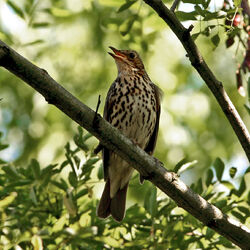| Song Thrush | |
|---|---|
 | |
| Scientific classification | |
| Kingdom: | Animalia |
| Phylum: | Chordata |
| Class: | Aves |
| Order: | Passeriformes |
| Family: | Turdidae |
| Genus: | Turdus |
| Species: | Turdus philomelos |
The Song Thrush (Turdus philomelos) is a common species of thrush that breeds across the West Palearctic.
Description[]
The Song Thrush measures 23 cm in length and 33-36 cm in wingspan. It has brown upperparts, a grayish tail and whitish-ochre spots on the wings on top. The underparts are whitish with a yellow-ochre tint on the chest and sides. Rounded or elongated blackish-brown spots are scattered all over the underparts except the vent.
Voice[]
The song of this bird, given by the male, is loud, clear and long, consisting of various low whistling sounds and musical phrases usually with loads of repetitions. A short, sharp tsip is also produced, which during migration replaces a high, squeaky seep, similar to the call of a Redwing, but shorter. The alarm call is a chook-chook, which becomes shorter and sharper as levels of danger increase.
Behavior[]
Feeding[]
The Song Thrush mainly feeds on prey from the ground. It feeds on earthworms, millipedes, small spiders, larvae, caterpillars, and flies, occasionally mollusks and berries.
Breeding and Nesting[]
Song Thrushes appear in nesting places in mid-April and soon begin to occupy appropriate places for nesting. The nest, arranged on trees and shrubs near the meadows, is located at a height of 1 to 10 meters from the ground, sometimes 2.5 m. It is a bulky structure resembling a bowl. It is made of dry leaves, plants, thin twigs, roots. Inside the surface is coated with clay with an admixture of wood chips. It is built in 3 days, 1-2 days is first treated with clay and after a day, it dries. After that, the female Song Thrush begins to lay eggs.
Song Thrushes have 2 clutches per year. The first laying takes place in late April - early May. 5-6 eggs are laid here. The female Song Thrush lays the second clutch in June, from 4-5 eggs. The color of the eggs of Song Thrushes are blue with small black and brown dots.
The eggs are incubated for 12-13 days. Both parents feed the chicks, and this happens around 150-200 times a day. After 13-15 days, the chicks begin to fledge and leave the nest.
Distribution and Habitat[]
The Song Thrush nests throughout Europe, except parts of the Iberian Peninsula, and in Asia east to Lake Baikal. In the 19th century, it was introduced to southeastern Australia, New Zealand and the New Hebrides, with successfully established populations present nowadays. The bird is partly migratory; birds from Western Europe are partly migratory and resident, while populations from northern parts of Europe and Siberia are exclusively migratory. Most European birds winter in the western Mediterranean and northern Africa. It nests in forests of all types, mainly on the edges in vegetation around watercourses and field forests. During the 20th century, similarly to the Common Blackbird, a part of its population moved from the forest environment to human settlements, and today, Song Thrushes also commonly nest in parks, gardens and cemeteries.
